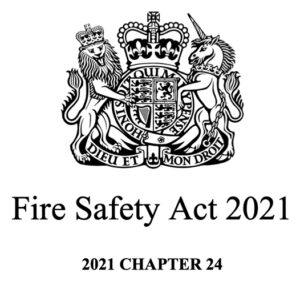For building owners and managers, its most critical, actionable guidance relates to the ongoing management of passive fire protection systems, mandating that fire doors are professionally inspected at least every six months. At Arrow Industrial, we provide a comprehensive fire door programme, from manufacturing and installation to inspection, repair, and maintenance, ensuring your building remains safe, compliant, and aligned with this vital standard.
This guide explains what BS 9999 is, its relationship with UK law, and how it directly impacts the most critical fire safety components in your building: your fire doors. We will detail what the standard recommends, what a compliant inspection involves, and how our integrated services provide you with a complete solution for safety and peace of mind.

Under the Regulatory Reform (Fire Safety) Order 2005 and the Fire Safety Act 2021, property owners and “Responsible Persons” must ensure that fire doors are kept in a fit state.
Standards such as BS 9999 provide guidance on how often inspections should be carried out, for example every six months.
Labels, certification, proper installation and maintenance are not optional — they are essential for legal compliance and for protecting lives.
BS 9999 is a comprehensive UK code of practice that provides a flexible, risk-based framework for achieving optimal fire safety throughout a building's entire lifecycle.
Fully titled BS 9999:2017 Fire safety in the design, management and use of buildings – Code of practice, this standard is not a rigid set of rules. Instead, it offers a detailed set of recommendations and guidance for best practice. Its scope is extensive, applying to new buildings, as well as to alterations, extensions, and material changes of use in existing buildings. The standard covers the full spectrum of fire safety considerations, including:
The standard sits between the prescriptive guidance found in the government's Approved Document B and the advanced, performance-based approaches of specialist fire engineering (such as BS 7974). It provides a more adaptable, yet structured, method for achieving safety.
A key feature of BS 9999 is its "risk-based" approach. The standard allows designers and fire safety professionals to classify buildings using risk profiles. These profiles are determined by assessing factors like building height, the types of occupants (e.g., are they awake and familiar with the building?), and the potential fire growth rate of the contents. This sophisticated approach allows for intelligent design trade-offs. For example, the installation of an automatic sprinkler system can lower a building's risk profile. This reduction in risk may then permit longer travel distances to exits or narrower stair widths, creating more usable floor space without compromising safety.
This flexibility means that a decision made by an architect at the design stage has direct, long-term consequences for you as the building manager. If a designer justifies a more open-plan layout by specifying high-performance FD60 fire doors at key locations, the entire safety case for that building relies on those doors being perfectly maintained for decades. A failure in maintenance effectively invalidates the original fire safety strategy. Therefore, for any building designed or managed under BS 9999 principles, a robust fire door maintenance programme is a fundamental requirement to uphold the integrity of the building's life safety system.
Our Comprehensive inspection covers;
Door Leaf and Frame Integrity
Hinges and Closers
Signage and Labels
Door Seals and Gaps
Glazing Integrity
Door Locks
Our fire door installation process covers;
Highest quality products
Product and installation come with guarantees
Expert Health and Safety support to carry out risk assessments
Qualified and accredited engineers
Our maintenance programmes cover;
Scheduled maintenance checks
Detailed personalised reporting highlighting actions
Choose how many visits per year you need
Detailed compliance report for your records
No, BS 9999 is not a piece of legislation and is not a direct legal requirement. However, it is the authoritative framework used to demonstrate compliance with the legally binding Regulatory Reform (Fire Safety) Order 2005.
Understanding the legal landscape is crucial. The primary fire safety law in England and Wales is the Regulatory Reform (Fire Safety) Order 2005 (RRO). This legislation places a legal duty on a designated "Responsible Person"—typically the building owner, employer, or facilities manager—to carry out a fire risk assessment and implement adequate fire safety measures.
The RRO tells you what you must do: manage fire risk. BS 9999 tells you how to do it to a high, nationally recognised standard. Following the guidance within BS 9999 is considered the definitive way to meet your legal obligations effectively. In the event of a fire, authorities, courts, and insurance providers will refer to established standards like BS 9999 to determine if the Responsible Person acted with due diligence. A failure to follow this established best practice can lead to severe consequences, including enforcement notices, unlimited fines, and even prosecution. Conversely, adherence demonstrates a serious commitment to safety, which can have positive impacts, such as potentially lower insurance premiums.
BS 9999 acts as a "safe harbour" for the Responsible Person. The RRO 2005 places a significant legal burden on you to ensure safety, which can create uncertainty. You may ask, "What is considered 'adequate' maintenance for my fire doors?" BS 9999 provides a concrete answer. By commissioning a service, like ours at Arrow Industrial, that adheres to this standard, you are creating a defensible, documented record of due diligence. You are aligning your actions with a British Standards Institution benchmark, effectively outsourcing the risk and gaining documented compliance and legal peace of mind.
BS 9999 establishes fire doors as critical components of a building's fire safety strategy and provides the definitive best-practice benchmark for their regular inspection and maintenance.
Fire doors are a fundamental form of passive fire protection. They are engineered assemblies designed to contain fire and smoke within a specific area, a principle known as compartmentation. This containment protects escape routes, such as corridors and stairwells, from becoming filled with deadly smoke and gives occupants valuable time to evacuate safely. The risk-based approach of BS 9999 relies heavily on these components functioning exactly as intended. A fire door that fails to close and latch properly renders the entire compartmentation strategy useless.
For building managers, the most practical and crucial aspect of the standard is the guidance it provides on the inspection and maintenance schedule for these vital assets.
BS 9999:2017 recommends that a routine inspection of all fire doors should be undertaken by a competent person at least every six months.
This six-monthly inspection is recognised across the industry as the primary best-practice guideline for most non-domestic buildings. It ensures that any wear, damage, or faults that develop through normal use are identified and rectified promptly, before they can compromise the door's performance in a fire.
It is important to note that doors in high-traffic areas, such as main corridors, school hallways, or hospital wards, are subject to significantly more wear and tear. Authoritative sources recommend that these doors may require more frequent checks to ensure their continued safe operation.
The regulatory landscape can be complex, as other specific laws may apply to your building. For example, the Fire Safety (England) Regulations 2022 mandate even stricter frequencies for multi-occupied residential buildings over 11 metres high. Our experts are versed in all applicable standards to ensure your inspection schedule is fully compliant.
To clarify these requirements, we have prepared the following guide.
| Standard / Regulation | Recommended Frequency | Applicable To |
|---|---|---|
| BS 9999:2017 | Every 6 months | General best practice for non-domestic buildings |
| Fire Safety (England) Regs 2022 | Every 3 months (communal doors) | Multi-occupied residential buildings >11m |
| Fire Safety (England) Regs 2022 | Every 12 months (flat entrance doors) | Multi-occupied residential buildings >11m |
| RRO 2005 (Article 17) | Regular maintenance required (frequency based on risk assessment) | All non-domestic premises |
A compliant inspection is a thorough, systematic check of the entire fire door assembly—not just the door leaf—to verify that every component is present, undamaged, and functioning correctly as per its original certification.
A common misconception is to view a fire door as just a piece of timber. In reality, it is a highly engineered "fire doorset" or "assembly." The door leaf, the frame, the intumescent seals, and all the hardware (hinges, closer, latch) work together as a single, tested system. Altering, damaging, or incorrectly replacing any single component can cause the entire system to fail. This is why a holistic, professional inspection that examines every element is essential for compliance and safety.
Our certified engineers conduct a meticulous inspection covering every critical aspect of the fire door assembly. This process ensures nothing is overlooked and provides you with a comprehensive understanding of your assets' condition. The seven key areas are:
Yes, many common fire door faults can be repaired by a competent specialist using approved techniques and certified components, restoring the door's compliance without requiring a full replacement.
Finding faults during an inspection does not always mean a costly replacement is necessary. Minor surface damage, worn or painted-over seals, misaligned self-closers, or faulty hardware can often be expertly rectified.
However, it is critical that these repairs are carried out only by a competent person with specific training in fire door maintenance. The use of non-fire-rated fillers, incorrect replacement hardware, or improper adjustments can permanently void the door's certification and render it unsafe. At Arrow Industrial, our repair services are performed by accredited technicians using approved techniques and certified parts. This approach can save you significant costs by repairing rather than replacing doors where possible, while still guaranteeing their performance and compliance.
Because we provide a complete, end-to-end fire door solution that guarantees compliance, safety, and peace of mind. Our expertise covers the entire lifecycle of a fire door, from manufacturing to maintenance.
A fire door is a complex, certified assembly, and managing it effectively requires a deep understanding of all its parts and how they interact. A company that only inspects can identify a problem, but cannot solve it. A company that only repairs might not use a component that is compatible with the original door certification.
Our integrated model provides a holistic understanding of the entire doorset lifecycle. We know how it is built, how it fails, and precisely how to fix it correctly. This comprehensive capability is our unique advantage, ensuring true, end-to-end compliance in a way that fragmented service providers cannot.
We offer a complete, circular fire door service programme to manage your fire door assets effectively.
Our service provides more than just functional doors; it provides a complete, auditable trail of compliance. Following every inspection and maintenance visit, we supply detailed reports, updated asset registers, and records of all activities carried out. This documentation is essential for you, the Responsible Person, to demonstrate due diligence to fire authorities, insurers, and in any legal proceedings. It is your proof that you have taken your responsibilities seriously.
Partnering with Arrow Industrial empowers you, the Responsible Person, to proactively manage your fire safety obligations, transforming a complex legal duty into a simple, managed process.
The principles are clear. BS 9999 sets the benchmark for fire safety management. The Regulatory Reform (Fire Safety) Order 2005 makes this management a legal requirement. Fire doors are a critical, and often vulnerable, part of this system.
Regular, professional inspection and maintenance are not optional; they are a cornerstone of due diligence and fundamental to protecting lives and property. By engaging with a specialist partner, you ensure that this critical task is handled correctly, documented thoroughly, and managed proactively.
Contact Arrow Industrial today to discuss how our comprehensive fire door programme can help you achieve and maintain total safety and compliance.

